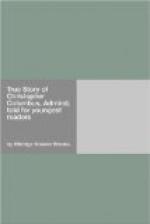But these, too, Columbus escaped, although not before his crews had grown terribly nervous for fear of capture. At last they got away from the Canaries, and on Sunday, the ninth of September, 1492, with a fresh breeze filling their sails, the three caravels sailed away into the West. And as the shores of Ferro, the very last of the Canary Islands, faded out of sight, the sailors burst into sighs and murmurings and tears, saying that now indeed they were sailing off—off—off—upon the awful Sea of Darkness and would never see land any more.
When Columbus thought that he was sailing too slowly—he had now been away from Palos a month and was only about a hundred miles out at sea—and when he saw what babies his sailors were, he did something that was not just right (for it is never right to do anything that is not true) but which he felt he really must do. He made two records (or reckonings as they are called) of his sailing. One of these records was a true one; this he kept for himself. The other was a false one; this he kept to show his sailors. So while they thought they were sailing slowly and that the ocean was not so very wide, Columbus knew from his own true record that they were getting miles and miles away from home.
Soon another thing happened to worry the sailors. The pilots were steering by the compass. You know what that is—a sort of big magnet-needle perfectly balanced and pointing always to the north. At the time of Columbus the compass was a new thing and was only understood by a few. On the thirteenth of September they had really got into the middle of the ocean, and the line of the north changed. Of course this made the needle in the compass change its position also. Now the sailors had been taught to believe so fully in the compass that they thought it could never change its position. And here it was playing a cruel trick upon them. We are trapped! they cried. The goblins in this dreadful sea are making our compass point wrong so as to drag us to destruction. Go back; take us back! they demanded.
But Columbus, though he knew that his explanation was wrong, said the compass was all right. The North Star, toward which the needle always pointed, had, so he said, changed its position. This quieted the sailors for a while.
When they had been about forty days out from Palos, the ship ran into what is marked upon your maps as the Sargasso Sea. This is a vast meadow of floating seaweed and seagrass in the middle of the Atlantic; it is kept drifting about in the same place by the two great sea currents that flow past it but not through it.
The sailors did not know this, of course, and when the ships began to sail slower and slower because the seaweed was so thick and heavy and because there was no current to carry them along, they were sure that they were somewhere near to the jumping-off place, and that the horrible monsters they had heard of were making ready to stop their ships, and when they had got them all snarled up in this weed to drag them all down to the bottom of the sea.




